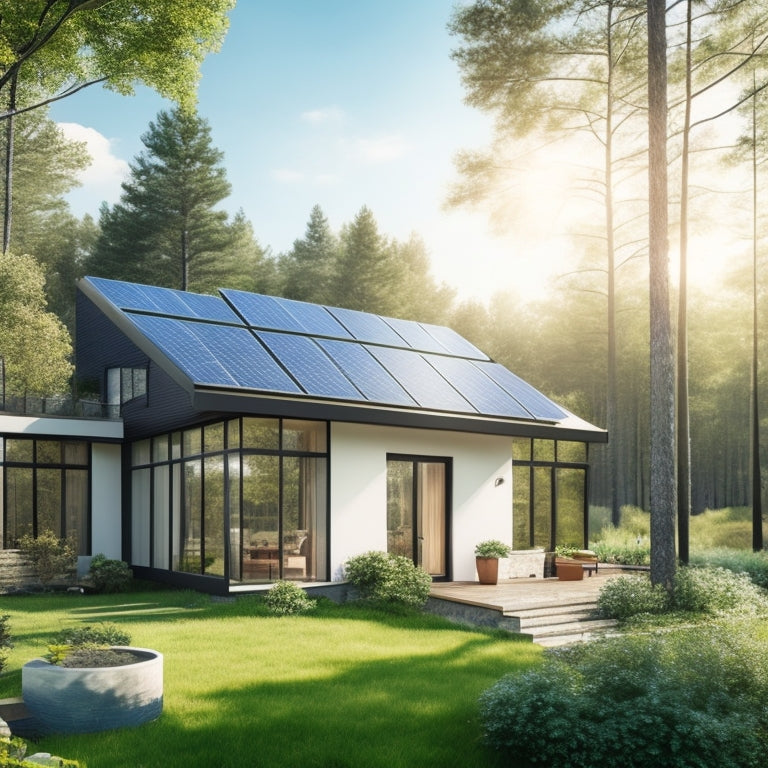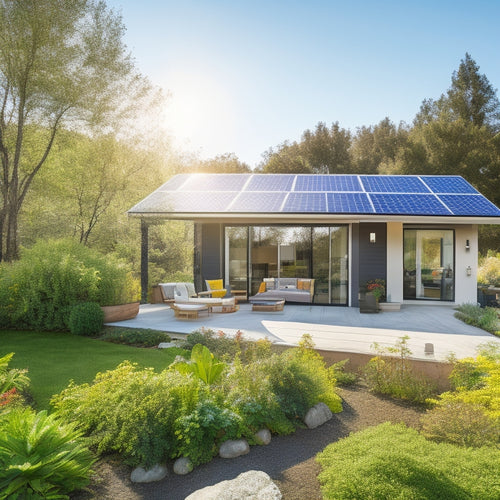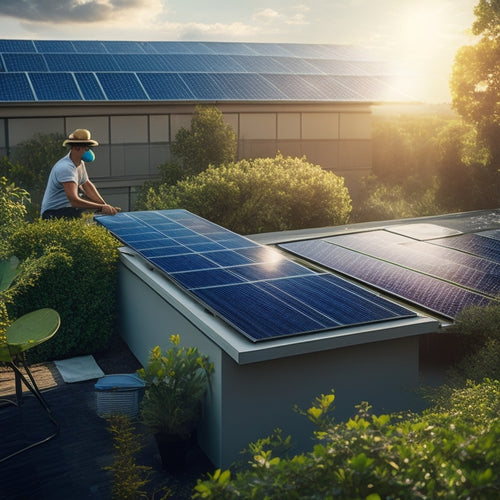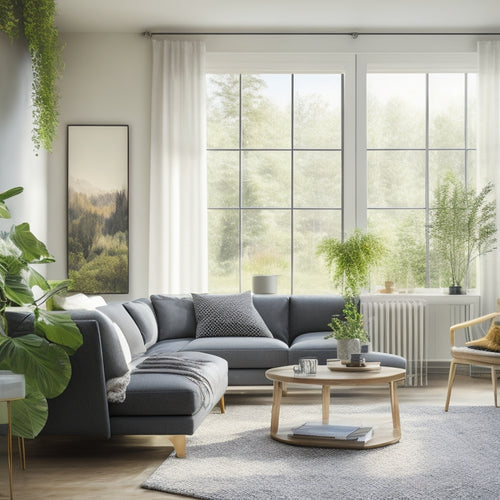
Essential Features for an Energy-Efficient Home With Solar
Share
When designing an energy-efficient home with solar, you'll want to incorporate key features to maximize its benefits. Start with proper insulation and air tightness to reduce heat loss and gain. Install energy-efficient windows and doors with low-E coatings to minimize heat transfer. Verify your solar panels are optimized with a suitable roof angle, orientation, and shading assessment. Smart home automation systems will help you monitor and control energy usage. Don't forget energy-star rated appliances, water conservation systems, and proper ventilation and cooling techniques. By combining these features, you'll be well on your way to an ultra-efficient home - and there's more to investigate to take your energy savings to the next level.
Key Takeaways
- Insulation and air tightness are crucial to reduce heat loss and gain, minimizing heating and cooling needs in an energy-efficient home with solar.
- Energy-efficient windows and doors with insulating glass, low-E coatings, and airtight frames prevent heat transfer and minimize energy loss.
- Solar panel installation factors, including roof size, angle, and orientation, as well as minimizing shading, are essential for optimal energy output.
- Smart home automation systems with energy monitoring and remote control capabilities help optimize energy consumption and pair well with solar power systems.
- Energy-Star rated appliances and water conservation systems, such as low-flow fixtures and rainwater harvesting, reduce energy and water waste in an energy-efficient home with solar.
Insulation and Air Tightness
As you commence on the expedition to create an energy-efficient home, one of the most crucial components to evaluate is insulation and air tightness.
Insulation plays a key role in reducing heat loss during winter and heat gain during summer, thereby minimizing the need for heating and cooling systems. You should consider using materials with high thermal mass, such as concrete or brick, which can absorb and release heat slowly, regulating the indoor temperature.
Proper air tightness is equally important, as it prevents heated or cooled air from escaping through gaps and cracks. Make certain that all joints and seams are sealed, and consider using radiant barriers to reflect heat rather than absorb it.
Radiant barriers can be especially effective in attics, where they can reduce summer heat gain by up to 97%. By combining effective insulation with air tightness, you can greatly reduce your energy consumption and create a comfortable, sustainable living space.
Energy-Efficient Windows and Doors
You're likely aware that windows and doors are important sources of heat loss and gain in your home.
To address this, you'll want to contemplate energy-efficient options that incorporate insulating glass, low-E-coated glass, and airtight frame designs.
Insulating Glass Options
Double- or triple-pane insulating glass options greatly reduce heat transfer, minimizing energy losses and gains through your windows and doors. This is achieved by trapping air or gas between the panes, reducing convection currents that facilitate heat transfer.
You'll notice a significant improvement in thermal performance, especially in extreme weather conditions.
When selecting insulating glass options, consider the type of glass coatings used. Low-E coatings, for instance, can reduce heat transfer by reflecting radiant heat rather than absorbing it.
This feature is particularly useful in climates with high temperatures or intense sunlight. You may also opt for tinted glass coatings, which absorb solar radiation and reduce heat gain during summer.
Additionally, some coatings can minimize visible light transmission, reducing glare and UV damage.
Low-E-Coated Glass Benefits
Low-E-coated glass takes insulating performance to the next level by minimizing heat transfer and maximizing energy efficiency.
When you invest in low-E-coated glass for your energy-efficient home, you're making a significant impact on your energy savings and environmental footprint.
By applying a thin metallic coating to the glass, low-E coatings reduce heat transfer between the inside and outside of your home.
This means you'll use less energy to heat and cool your home, resulting in lower energy bills and a reduced environmental impact.
Some key benefits of low-E-coated glass include:
-
Improved thermal performance: Low-E coatings minimize heat transfer, keeping your home warm in the winter and cool in the summer.
-
Enhanced UV protection and glare reduction: Low-E coatings block UV rays, reducing glare and protecting your furniture and carpets from fading.
-
Maximized energy savings: By reducing heat transfer, low-E coatings help you save energy and reduce your carbon footprint.
Airtight Frame Design
Your energy-efficient home's windows and doors play an essential role in maintaining a comfortable indoor climate, and airtight frame design is a significant component in achieving this goal. A well-designed frame guarantees that your windows and doors are sealed tightly, preventing air leaks and minimizing heat transfer. This is vital in maintaining a consistent indoor temperature, reducing the need for heating and cooling, and ultimately saving you energy costs.
When it comes to frame materials, you'll want to opt for durable, low-maintenance options like vinyl, fiberglass, or aluminum. These materials are resistant to warping, cracking, and rotting, guaranteeing a tight seal over time.
Additionally, consider the design aesthetics of your frame. A sleek, modern design can enhance your home's curb appeal while also providing improved functionality. Look for frames with a narrow profile to maximize natural light and unobstructed views.
Solar Panel Installation Factors
When installing solar panels, you'll need to evaluate several key factors that impact their energy-generating potential.
First, you'll need to assess your roof's size and angle to determine the ideal placement and number of panels.
Additionally, you'll want to guarantee the panels are oriented correctly and that shading from surrounding trees, buildings, or other obstructions won't hinder their performance.
Roof Size and Angle
Optimizing roof size and angle is vital for maximizing solar panel energy output. As you plan your energy-efficient home, take into account the following factors to guarantee you're getting the most out of your solar panels.
The size of your roof determines how many solar panels you can fit, which directly affects energy production. A larger roof provides more space for panels, increasing energy output.
However, it's important to take into account the type of roof materials you're using. For example, solar shingles can be more expensive than traditional roofing materials, but they provide a seamless integration with your solar panel system.
To maximize energy output, contemplate the following:
-
Roof angle: A roof angle between 30 and 45 degrees is ideal for solar panels, as it allows for the best energy absorption.
-
Shading: Make sure your roof receives minimal shading from trees, buildings, or other obstructions, which can greatly reduce energy output.
-
Roof orientation: While we'll discuss panel orientation in more detail later, it's important to take into account how your roof's orientation affects solar panel energy output.
Panel Orientation Matters
The orientation of your solar panels greatly impacts their energy output, making it an important consideration in your energy-efficient home design. When planning your solar panel installation, you'll want to guarantee your panels are positioned to maximize energy production.
Ideally, your solar panels should face directly at the sun's path, which varies depending on your location and time of year. In the northern hemisphere, a south-facing orientation is generally best, while in the southern hemisphere, a north-facing orientation is most effective.
To further enhance panel efficiency, consider incorporating solar tracking systems. These systems adjust the angle and orientation of your panels throughout the day to capture the most sunlight. By doing so, you can increase your energy output by up to 45%.
Even slight variations in panel orientation can greatly impact your energy production, so it's vital to get it right. By carefully considering your panel orientation, you can maximize your energy output and make the most of your solar investment.
Shading Impact Assessment
Beyond panel orientation, another vital factor to take into account in your solar panel installation is the impact of shading on energy production.
Shading can greatly reduce the energy output of your solar panels, making it essential to assess and mitigate its effects.
You'll need to identify the types of shading that affect your installation, such as tree shade, building shade, or self-shading from the panels themselves.
Then, you can investigate shading solutions that work for your specific situation.
Some important considerations for your shading impact assessment include:
- Shading calculations: Determine the extent of shading on your solar panels and its impact on energy production.
- Shading materials and technologies: Select materials and technologies that minimize shading effects, such as bifacial panels or thin-film panels.
- Shading optimization and analysis: Use software and modeling tools to analyze shading patterns and optimize your panel placement for maximum energy output.
Smart Home Automation Systems
Your smartphone doubles as a remote control for your life, so why not for your home too?
With smart home automation systems, you can control and monitor your energy usage from the palm of your hand. This integration allows you to optimize your energy consumption and make data-driven decisions to reduce your carbon footprint.
Smart thermostat integration enables you to adjust the temperature of your home remotely, ensuring you're not wasting energy when you're not there.
Energy monitoring tools provide real-time data on your energy usage, helping you identify areas of inefficiency and make adjustments accordingly. These features can be especially beneficial when paired with solar power, as you can monitor your energy production and consumption simultaneously.
Energy-Star Rated Appliances
Optimizing your home's energy efficiency doesn't stop at smart automation systems. Another vital aspect to take into account is the appliances you use daily.
Energy-Star rated appliances are a must-have for any energy-efficient home. These appliances are designed to consume less energy while providing the same level of performance as traditional appliances.
By choosing Energy-Star rated appliances, you can:
- Reduce your energy consumption, leading to significant energy savings over time
- Increase appliance longevity, as they're built to last with energy-efficient components
- Contribute to a more sustainable future, as these appliances produce fewer greenhouse gas emissions
Some examples of Energy-Star rated appliances include refrigerators, washing machines, and air conditioners.
When shopping for new appliances, look for the Energy-Star label to guarantee you're getting an energy-efficient model.
Water Conservation Systems
Two of the most notable contributors to water waste in homes are toilets and showerheads. You can greatly reduce your water consumption by installing low-flow toilets and showerheads.
Look for fixtures with the WaterSense label, which indicates they meet EPA standards for water efficiency.
Another critical aspect of water conservation is harvesting and reusing water. You can implement rainwater harvesting systems to collect and store rainwater for non-potable uses like flushing toilets, washing cars, or irrigating your garden.
Greywater recycling systems can also be installed to reuse water from sinks, showers, and washing machines for irrigation and flushing toilets.
Proper Ventilation and Cooling
As you strive to create an energy-efficient home, proper ventilation and cooling become essential components of your overall strategy. A well-designed ventilation system guarantees a healthy indoor environment by removing stale air and introducing fresh air, reducing the need for air conditioning. This, in turn, diminishes your energy consumption and saves you money.
To achieve peak ventilation and cooling, consider the following strategies:
-
Natural Ventilation: Design your home to maximize natural ventilation through strategically placed windows, clerestory windows, and solar chimneys. This allows warm air to escape and cool air to enter, reducing the need for mechanical cooling systems.
-
Passive Cooling: Incorporate passive cooling techniques, such as shading devices, insulation, and reflective roofing materials, to reduce heat gain during summer months.
-
Whole-House Fans: Install whole-house fans to circulate air and pull hot air out of your home, reducing the need for air conditioning.
Frequently Asked Questions
Can I Install Solar Panels on My Existing Roof?
You can install solar panels on your existing roof if its structure can support the added weight and you obtain necessary installation permits, ensuring a safe and compliant setup that utilizes renewable energy efficiently.
How Long Does It Take to See a Return on Investment?
You'll be surprised to know that 80% of solar panels still produce 80% of their original power after 25 years. When calculating your investment, you'll find the payback period varies, but on average, it takes 5-7 years to break even, depending on your energy usage and local incentives.
Are Energy-Efficient Homes More Expensive to Build?
You'll likely pay more upfront for an energy-efficient home, but a cost comparison reveals long-term savings through reduced energy consumption, offsetting the initial investment and putting you ahead in the long run.
Can I Use Solar Energy to Power My Electric Vehicle?
You can definitely use solar energy to power your electric vehicle, but you'll need to guarantee your vehicle is compatible with solar charging systems and invest in a high-capacity solar panel array to meet your vehicle's energy demands.
Do Energy-Efficient Homes Require More Maintenance?
You're wondering if energy-efficient homes require more maintenance? Take the example of a California net-zero energy home, which requires bi-annual HVAC filter changes, but yields maintenance benefits and long-term savings of up to $1,000 annually.
Conclusion
As you step into your energy-efficient home, powered by solar energy, you'll feel like you're walking into a serene oasis. With insulation and air tightness sealing in comfort, energy-efficient windows and doors letting in natural light, and smart home automation systems humming in the background, you'll be basking in a cocoon of sustainability. The cherry on top? Your reduced carbon footprint, a badge of honor in the fight against climate change.
Related Posts
-

Green Home Improvements Using Solar Power
Investing in solar power alters your home into a sustainable haven while slashing energy costs. You can greatly reduc...
-

Green Ways to Maintain Solar Panels
To maintain your solar panels sustainably, start with regular inspections to catch potential issues early, enhancing ...
-

Energy-Efficient Heating and Cooling Appliances
Energy-efficient heating and cooling appliances can cut your energy bills markedly. By opting for models with high En...


